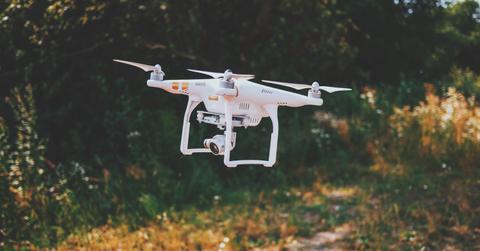The Surprising Way Drones Can Help Fight Climate Change
Drones can do everything from take beautiful photos to deliver your groceries. But their ability to thwart climate change may be the little gadgets' crown achievement.
Updated May 14 2019, 4:39 p.m. ET
Drones today serve a variety of functions, from capturing aerial photography to assisting in military operations. But one particular service may end up being their chief contribution: by acting as mitigating forces against the impacts of climate change. These little gadgets are now capable of everything from fighting dwindling bee populations and reducing carbon emissions to tracking changes in wildlife population and gathering water samples.
Drones are perfect data collectors.
Perhaps the most prominent way in which drones help fight climate change is by assisting with data collection. Drones can travel to places where humans cannot easily go, thereby reducing research costs and increasing the accuracy of data collection.
Researchers at Cornell University have used drones to measure surface reflectivity, logging how much solar energy a landscape reflects and absorbs. This measurement is crucial for understanding climate change, and can help forest planners determine which locations to plant trees to get the most climate benefit. Satellites typically gathered this information in the past, but drones have the advantage of being more agile.
Drones are also ideal for collecting information on air quality, monitoring wildlife population and activities, and calculating deforestation rates. Gathering data in this way also improves researcher safety: Helicopter and small plane crashes are the leading cause of on-the-job deaths for wildlife biologists.
We typically think of drones as being aerial, but they can also explore underwater environments. Researchers can deploy underwater drones to collect water and sediment samples, and use the data to analyze the impacts of climate change and human activities on ocean ecosystems. This also increases researcher safety by reducing the need to send human divers to collect samples.
Drones can even watch for and stop poaching and illegal logging. The sight of a drone switching on its navigation lights is typically enough to scare off would-be criminals.
Drones can plant trees and (almost) replace bees.
Drones can also assist in ways that go beyond monitoring. They can also help to alleviate the impacts of climate change and assist with tasks that nature struggles to complete due to changing environmental conditions.
A company called BioCarbon Engineering created a drone that can plant trees from the air. The 30-pound vehicle fires seed pods with precision from 10 feet above the ground. The device can plant 120 trees per minute, much more than human planters can. Planting trees slows climate change and other environmental harm by sequestering carbon, improving air and water quality, and preventing erosion.
Bees have been dying off in huge numbers due in part to climate change. This is cause for serious worry, since bees provide many crucial environmental services, including pollinating a range of plant life, as well as many fruit and nut crops.
Where bees are struggling, small drones could step in. Japan's National Institute of Advanced Industrial Science and Technology used a 1.5-inch drone to pollinate Japanese lilies last year. Walmart recently applied for a patent for a similar technology.
Drones can help us reduce greenhouse gas emissions.
Using drones instead of trucks to deliver packages could help reduce emissions associated with package delivery, according to a recent study in Nature. The most environmental rewards are reaped by using drones for the last legs of the delivery of small items, potentially offering a massive reduction in carbon dioxide emissions of trucks traveling to individual homes from loading stations.
Amazon first successfully tested drone delivery services in December 2016, and has indicated plans to continue pursuing this technology.
Drones could also play a role in the clean energy industry, the success of which is key for stopping climate change. Drones can quickly and cost-effectively assess potential sites for solar and wind plants and conduct inspections of existing facilities. Duke Energy has experimented with infrared cameras affixed to drones to check for malfunctions.
On a solar farm, workers typically do inspections by slowly making their way through the field of solar panels. To inspect a wind turbine, for example, a worker must climb to the top of a tower and then dangle by wire, a time-consuming and potentially dangerous task. Drones could also help to inspect the vast network of transmissions lines our electrical grid depends on.
Climate change is a problem impacting every part of our world, including the creatures that live in it. To understand the impacts of climate change and mitigate them, we need to go to places that are hard to access — something drones excel at. Whether they’re in the air or underwater, drones may be a vital tool in finding solutions to the many challenges of climate change.
